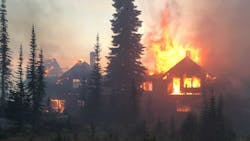An independent investigation into a August 2017 wildfire that destroyed a historic structure in a Montana national park recommends additional training for wildland firefighters but also emphasizes that their valiant efforts don't always result in saving property.
The Sprague Fire, as it came to be known, was ignited by a lightning storm on Aug. 10, 2017, on the north side of Sprague Creek and eventually scorched nearly 17,000 acres within Glacier National Park.
Although no firefighters were killed or injured while containing the massive blaze, a sense of great loss was felt by park employees and enthusiasts when the blaze eventually reached the historic Sperry Chalet, which was built in 1913 and is listed as a National Historic Landmark.
The Sperry Chalet was built as part of a massive effort to boost tourism along The Great Northern Railway and was only accessible by trail. The complex consisted of several buildings, most notably the Dormitory and the Dining Hall along with several other non-historic structures such as washroom and maintenance facilities.
The initial small size of the Sprague Fire prevented heavy resources from being deployed, leaving air drops to serve as the primary containment effort until ground crews could be inserted for suppression.
Unfortunately, the limited resources available to contain the fire were overrun during significant evening growth over several days, which resulted in the fire management team deciding to evacuate the now at-risk Sperry Chalet.
Crews were assigned to wrap several of the structures and create containment lines around the complex, but due to the intricate Swiss-style architecture of the Dormitory and Dining Hall, firefighters would have been at significant risk trying to completely wrap the upper portions of the wooden structures.
Improvements were also made to the sprinkler systems, while standing dead trees and dry brush were cleared, although a communications misunderstanding led the firefighters at the complex to believe they were not to cut any green trees.
Despite all prevention efforts by crews at the complex, embers from the approaching fire made their way into openings in the upper portions of both the Dormitory and the Dining Hall. Firefighters were able to suppress the blaze in the Dining Hall, but the Dormitory was lost to the fire.
The independent review has offered several recommendations in the wake of the fire:
- Target specific wildland firefighters for training focused on parks with remote, high-risk historic structures.
- Consider enhanced training on handling effective structure wrapping, implementing water systems and collapse zones.
- Appropriate measures to successfully wrap a structure should be taken even if firefighters have to accept some vulnerability.
- REAFs (Resource Advisor Fireline-Qualified) should be on location when protection efforts are made at historic structures.
- The National Park Service should consider installing external quick connect sprinklers on historic structures during fire events.
- Written Standard Operating Procedures (SOPs) on acceptable mitigation actions should be identified prior to fire events.
- Messaging with the public should emphasize Firewise practices on prevention and reporting to National Park staff.
Another main point of emphasis amid the recommendations in the report is that fire crews managed to contain 18 of the 22 fires that were ignited in Glacier National Park last year to below three acres in size.
The National Park Service is planning on better communicating to the public these successful efforts by wildland firefighters, and also noting the fact that despite doing everything they can to protect property, there are going to be unavoidable losses.






